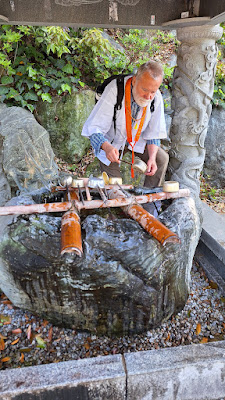The smallest of Japan's major islands, Shikoku, is famous for a pilgrimage path which circles the island highlighting stops at 88 temples. The walking route honors the Shikoku born monk, Kobo Daishi (774 –835), who was influential in establishing Shingon Buddhism in Japan after his studies in China. Kobo Daishi practiced at many of the sacred temples and his carved image is a prominent feature at most of the temple sites.
Completing the walk to all 88 temples takes approximately 60 days, so with our 2 weeks in Shikoku we planned on visiting as many temples as possible from our bases in Tokishima and Kochi. Our first stop was the Henro (Pilgrim) visitors center at Ryozen-ji (Temple 1), where we purchased our official Henro supplies. Most pilgrims obtain a Hakui (white jacket), Wasega (embroidered stole), Kasa (conical sedge hat), walking stick, incense, and book to receive the temple stamps required as evidence of completion.
The route between temples is generally well marked, although the markers did vary:
While each Temple we visited was different, the ritual upon entry remained the same: Bow at the gate, ring the temple bell, wash hands, light incense, make an offering, and at the Hondo (main hall) recite the Heart Sutra (The Heart of the Perfection of Wisdom).

Upon completion of the required tasks, each Henro proceeds to the office to receive the temple stamps and calligraphy in their pilgrimage book.
Walking between temples through small villages and farms, allowed us a unique opportunity to appreciate rural Japan.
The Japanese we met along our journey were especially helpful with directions and on several occasions presented us with bottles of iced tea and oranges from their garden. Presenting gifts to pilgrims is a custom called Osettai, and such offerings bestow religious merit, so we received each gift with gratitude.
At the end of each day's temple walks we would take a local train, though most often a rural bus back to our evenings accommodation, only to return the next day to pick up where we left off. Thanks to the official guide book we were able to find the bus stops, although unlucky timing often meant a bit of a wait.
While some modern day pilgrims follow the route by car or with organized bus tours, most fellow pilgrims we met approached each temple on foot. Regardless of motivation, I believe, by walking the path, each Henro has the time to meditate, reflect and appreciate the true spiritual nature of the journey.
During our 2 weeks we were able to visit 23 of the 88 temples, and the walks were mostly pleasant and easy going, though some required a bit more effort. In the end, we look back with gratitude and joy for having experienced a bit of this noble pilgrimage route and will always cherish our temple books.
Short video captures the Shikoku 88 Pilgrimage experience:
https://www.youtube.com/watch?v=z2UyhlFM_yc&t=26s
For more information on the Shikoku Pilgrimage, including history, ritual, chants, and practical planning, see the following PDF Shikoku Pilgrimage A Guide For Non-Japanese:






























Comments
Post a Comment